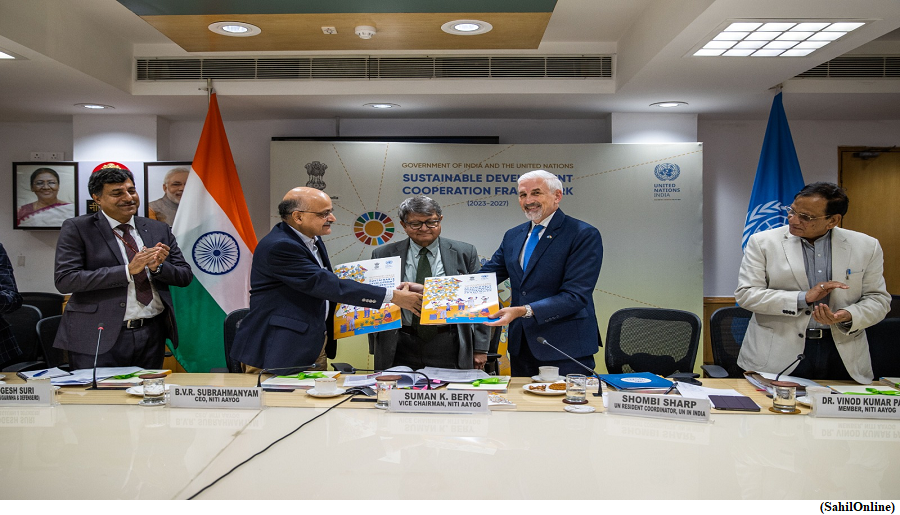NITI Aayog and the United Nations sign the GoI UNSDCF 2023-2027 Framework (GS Paper 2, Governance)

Why in news?
- NITI Aayog and the United Nations in India signed the Government of India - United Nations Sustainable Development Cooperation Framework 2023-2027 recently.
What is GoI-UNSDCF 2023-2027?
- GoI-UNSDCF 2023-2027 represents the UN development system’s collective offer to the Government of India, in line with the national vision for development, for the achievement of the Sustainable Development Goals, promoting gender equality, youth empowerment and human rights.
- The UN General Assembly Resolution designates the United Nations Sustainable Development Cooperation Framework as the principal planning and implementation instrument for the UN Development System at country level.
- Programme priorities of the UN entities working at the country are derived from the GoI-UNSDCF.
Strategic pillars:
- The GoI-UNSDCF 2023-2027 is built on four strategic pillars derived from the 2030 Agenda – People, Prosperity, Planet and Participation.
- The four interlinked pillars have six outcome areas focusing on
- Health and Well Being;
- Nutrition and Food Security;
- Quality Education;
- Economic Growth and Decent Work;
- Environment, Climate, WASH and Resilience; and
- Empowering People, Communities, and Institutions.
SDG localisation & South-South cooperation:
- To further deepen cooperation in critical areas, for the first time, the GoI-UNSDCF will have specific focus on SDG localisation and South-South cooperation, in line with India’s leadership towards the implementation and acceleration of the SDGs; and India’s championing of South-South cooperation. Showcasing Indian models of development globally will be central to the effort.
Implementation:
- The implementation, monitoring and reporting of GoI-UNSDCF 2023-2027 will be co-led by Government of India and the United Nations, India through a Joint Steering Committee.
Way Forward:
- The new Framework comes at a critical juncture as the world reaches the halfway mark to achieve the 2030 Agenda for Sustainable Development, and India envisions a ‘Viksit Bharat’ over the next 25 years.
New model for improving high frequency radio communications, crucial during natural disasters
(GS Paper 3, Disaster Management)
Why in news?
- A new model for radio wave propagation through the ionosphere developed by scientists can help estimate the impact of space weather and facilitate the planning and operation of High Frequency (HF) radio communications, a vital means of communication during the situations like natural disasters, and mid-ocean surveillance.

Skywave communications:
- The ionosphere is a region of Earth’s upper atmosphere ranging from about 100 - 1000 km and acts as a gateway for radio communication between the ground and space.
- Radio waves of certain frequencies (HF band) are reflected back to the ground by the ionosphere which facilitates long-distance HF communications beyond the horizon, known as Skywave communications.
Disturbance:
- Despite the increasing use of satellite communications, traditional long-distance high-frequency (HF) radio communication, remains a vital means of communication during the situations like natural disasters, mid-ocean surveillance, over-the-horizon target detection, and so on.
- Severe ionospheric disturbances that arise due to a range of space weather events like Solar flares, Coronal Mass Ejections (CMEs), and Geomagnetic storms significantly affect Skywave communications.
- This variability of ionosphere due to disturbances in space weather can significantly limit the usage of Skywave communications.
New model:
- Scientists of the Indian Institute of Geomagnetism (IIG), have recently developed a model for HF radio wave propagation through the ionosphere which helps in studying the impacts of space weather effects on the ionosphere and Skywave communication systems.
- They have found a deep depletion of the ionosphere over the low latitudes of the Indian sub-continent region due to a severe geomagnetic storm in March 2015.
- The model indicates that this ionospheric depletion can severely limit the usable HF spectrum by more than 50% for Skywave communication during this disturbed period.
- Also, the skip-zones where the Skywave signals are not receivable are expanded for very large areas resulting in the loss of communications. This information is crucial for developing robust strategies in mitigating the space effects on Skywave communication systems.
Way Forward:
- This model has important applications in planning the right strategies for the operation of Skywave communication systems during active space weather periods.
- The development of such strategies is essential for ensuring reliable Skywave communication systems in the face of natural disasters and other emergencies.



